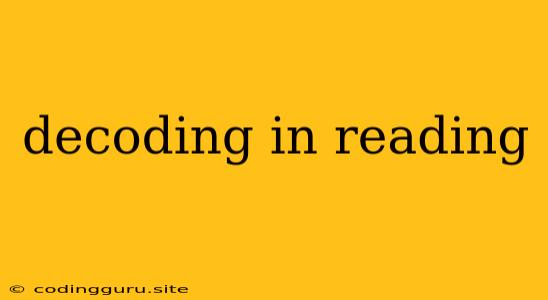Decoding in Reading: Unlocking the Power of Text
Decoding in reading is a foundational skill that lays the groundwork for fluent and proficient reading. It's the process of translating written symbols into spoken language, allowing us to understand the meaning of words and sentences. While decoding is often associated with early reading, it's a skill that continues to develop throughout our lives, enabling us to tackle increasingly complex texts.
What is Decoding in Reading?
Imagine a child encountering the word "cat" for the first time. They see the letters "c-a-t" but don't yet understand their relationship to the sound of the word. Decoding helps bridge this gap. It involves recognizing the individual letters or letter combinations within a word, understanding the sounds they represent, and blending those sounds together to form the spoken word.
Think of decoding as a code-breaking puzzle. We learn to decipher the visual representation of letters and translate them into the sounds we recognize in spoken language.
Why is Decoding Important?
Decoding is the key to unlocking the world of text. Without it, reading becomes a frustrating and challenging endeavor. Decoding enables us to:
- Read fluently: Strong decoding skills allow us to read words quickly and effortlessly, freeing up our cognitive resources to focus on comprehension.
- Develop vocabulary: By decoding words, we encounter new vocabulary and begin to understand their meanings within the context of a sentence or paragraph.
- Build a foundation for comprehension: Strong decoding skills are essential for comprehending complex texts. When we decode accurately, we are better able to grasp the meaning of what we are reading.
- Enjoy reading: When we can decode easily, reading becomes a pleasurable and engaging experience. We can explore new worlds, learn new things, and connect with others through the written word.
How Can We Improve Decoding Skills?
Building strong decoding skills requires a multifaceted approach. Here are some tips for individuals and educators alike:
1. Phonics Instruction:
- Focus on letter-sound correspondence: Understanding the connection between letters and their sounds is fundamental to decoding. Explicitly teach and reinforce these connections through activities, games, and interactive tools.
- Introduce phonics patterns: Highlight common letter combinations like "sh," "th," and "ch" to help students decode words efficiently.
- Provide practice opportunities: Offer ample opportunities for students to apply their phonics knowledge by reading decodable texts and engaging in word-building activities.
2. Develop Sight Words:
- Teach high-frequency words: Certain words occur frequently in texts, and knowing them by sight can significantly improve reading fluency.
- Utilize flash cards and games: Interactive methods like flash cards and word games can help students learn and recognize these common words.
- Integrate sight words into context: Encourage students to use sight words in writing and speaking to enhance retention and application.
3. Encourage Reading:
- Read aloud frequently: Reading aloud to children exposes them to a wide range of vocabulary and sentence structures, strengthening their decoding abilities.
- Provide access to a variety of texts: Offer books at different reading levels and genres to cater to individual interests and challenge students appropriately.
- Create a supportive reading environment: Make reading a regular and enjoyable activity in the home or classroom, fostering a love of books and encouraging active participation.
4. Utilize Technology:
- Interactive phonics apps: Games and apps can make learning phonics fun and engaging, providing individualized practice and feedback.
- Online reading programs: Adaptive programs can assess students' reading levels and provide targeted instruction based on their needs.
- Digital dictionaries: Encourage students to use digital dictionaries to look up unknown words and explore their meanings in context.
5. Address Decoding Challenges:
- Identify specific areas of difficulty: Observe and analyze students' reading behaviors to pinpoint areas where they may be struggling with decoding.
- Provide individualized support: Offer personalized instruction and intervention tailored to each student's unique challenges.
- Collaborate with professionals: Seek guidance from reading specialists or other educators to create appropriate strategies for addressing specific decoding difficulties.
Examples of Decoding in Action
Here are some examples of how decoding plays out in real-life reading situations:
- A young child sounds out the word "cat": They recognize the letter "c" as making the "k" sound, the "a" as making the "a" sound, and the "t" as making the "t" sound. They then blend these sounds together to pronounce the word "cat."
- A teenager reads a complex sentence: They decode each word individually, utilizing knowledge of phonics patterns and vocabulary to understand the meaning of the sentence as a whole.
- An adult reads a technical document: They decode specialized vocabulary and technical jargon, relying on their understanding of prefixes, suffixes, and root words to grasp the content.
Conclusion
Decoding is a fundamental skill that underpins successful reading. By understanding the process of translating written symbols into spoken language, we empower individuals to become fluent and confident readers. Through targeted instruction, engaging activities, and a love of reading, we can help learners develop strong decoding abilities and unlock the power of the written word.
